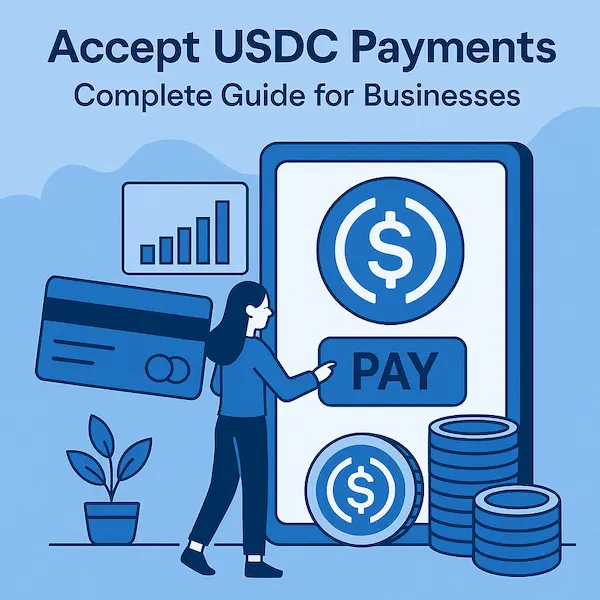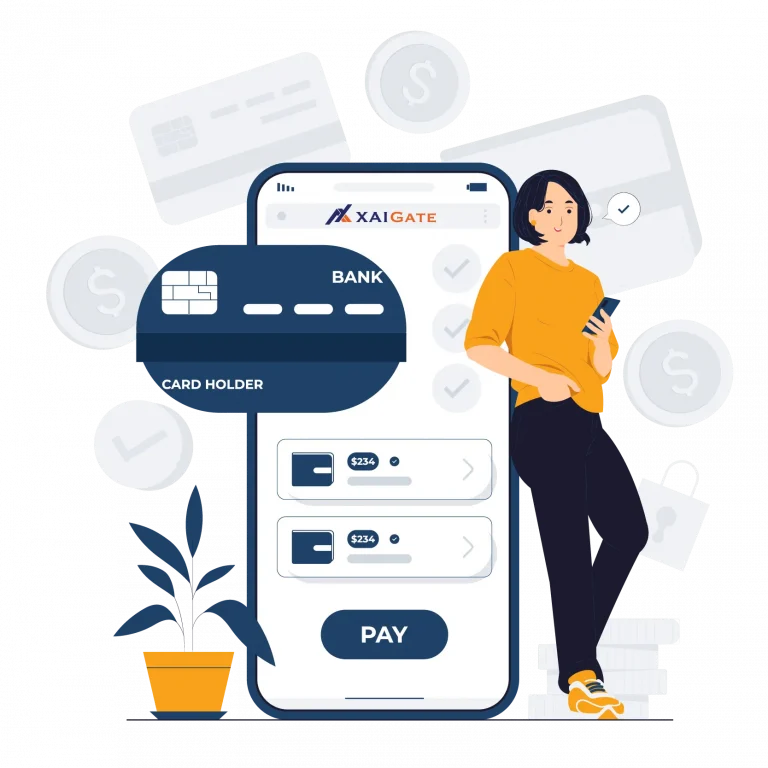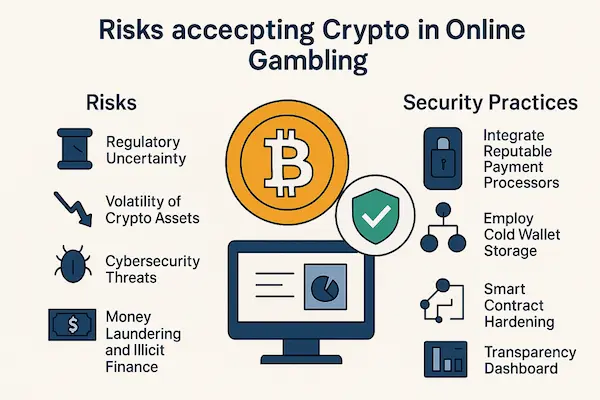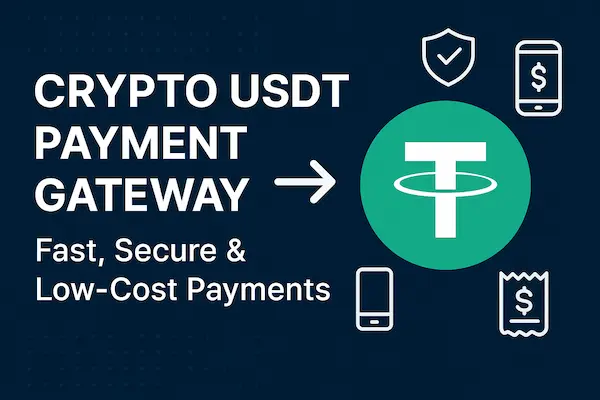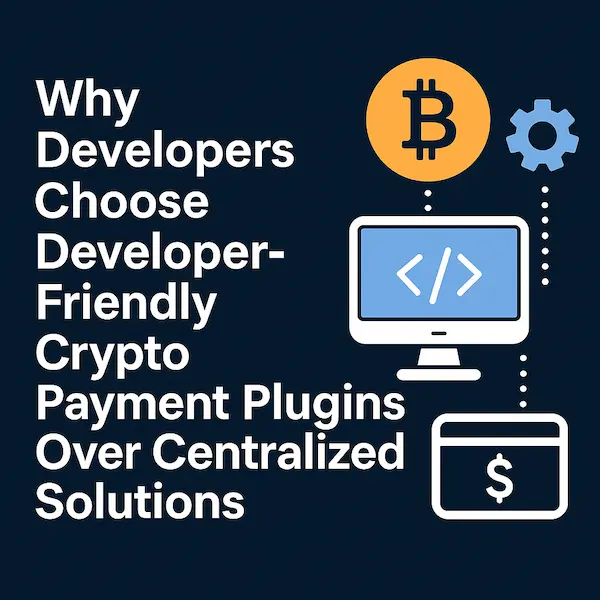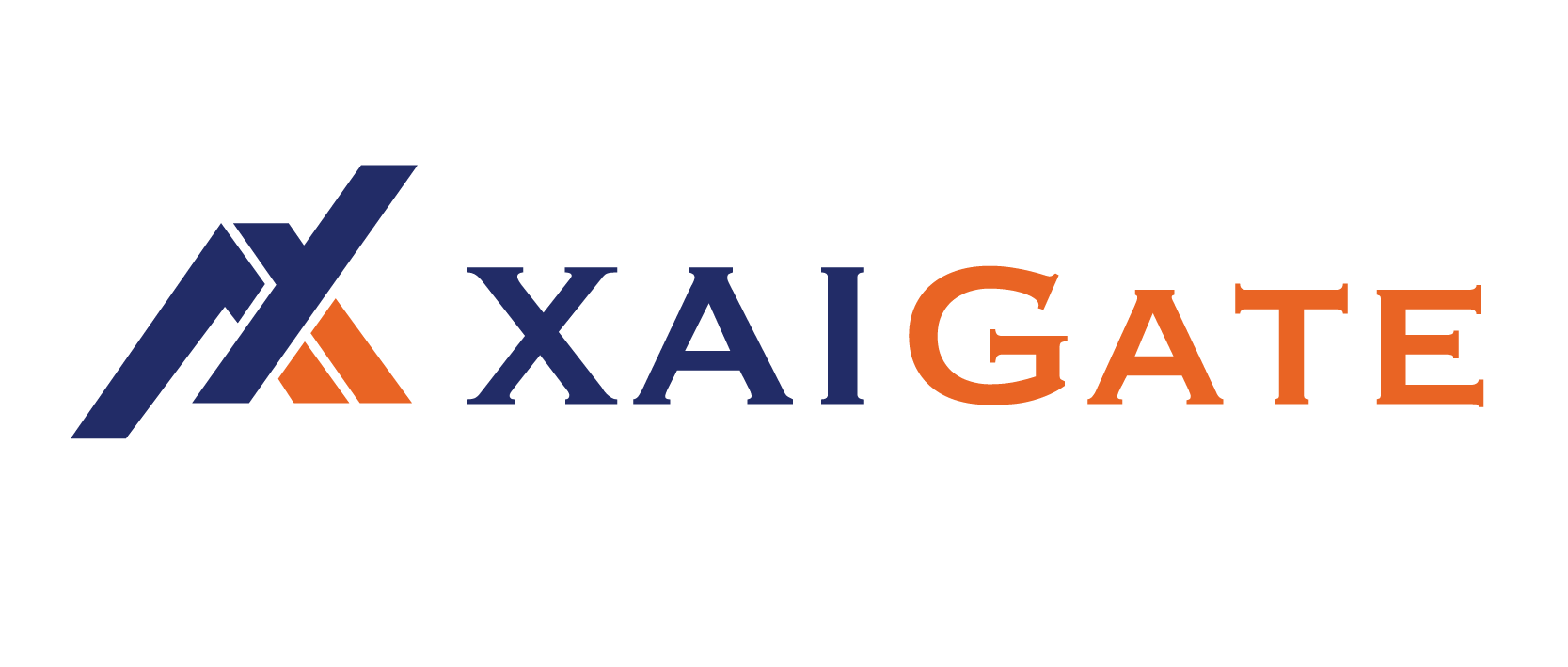Contents
- 1 1. Introduction – USDC as the Digital Dollar of 2026
- 2 2. Stablecoins in the Global Economy
- 3 3. The Growth of USDC Adoption (2026 Insights)
- 4 4. Pain Points of Traditional Payments
- 5 5. Why Businesses Should Accept USDC Payments
- 6 6. Integration Models for Accepting USDC
- 7 7. Real-World Examples & Case Studies
- 8 8. Compliance, Security & Accounting
- 9 9. Future of USDC in Global Payments
- 10 10. Strategic Recommendations for Businesses
- 11 Final Thoughts: Why Businesses Should Accept USDC Payments in 2026
- 12 FAQs – Accept USDC Payments
1. Introduction – USDC as the Digital Dollar of 2026
Digital payments are evolving faster than ever. Businesses are no longer limited to credit cards, bank transfers, or PayPal when serving global customers. Instead, they are exploring faster and more cost-effective solutions such as stablecoins. Among them, USDC (USD Coin) has emerged as one of the most trusted options. Unlike volatile assets like Bitcoin, USDC is pegged 1:1 to the U.S. dollar and fully audited, making it highly reliable for everyday transactions.
In 2026, more companies are starting to accept USDC payments as part of their standard checkout process. From e-commerce stores to NGOs and freelancers, USDC is becoming the “digital dollar” of the internet economy. Its combination of low fees, instant settlement, and compliance-friendly design gives businesses a clear reason to adopt it sooner rather than later.
This guide explains why now is the right time to accept USDC payments, what benefits it brings, and how to integrate it into your business model. By the end, you’ll see how this stablecoin can help reduce costs, expand your reach, and strengthen customer trust.
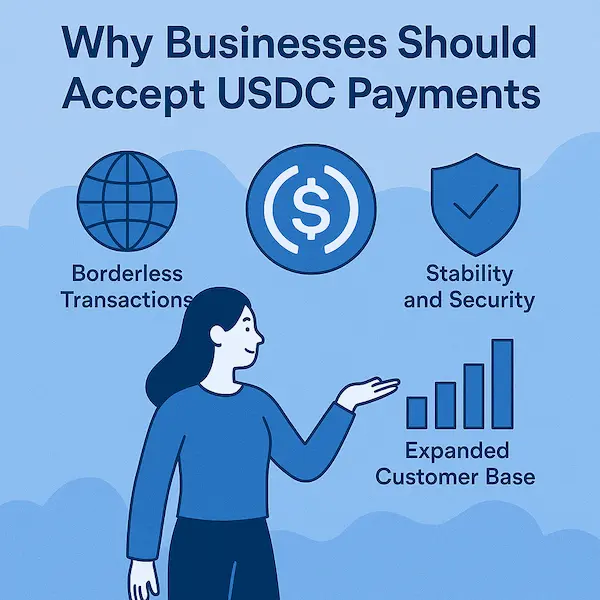
2. Stablecoins in the Global Economy
Stablecoins have quickly evolved from niche crypto assets into critical tools for global commerce. They combine the stability of traditional currency with the efficiency of blockchain, offering businesses faster, cheaper, and more transparent transactions. For companies that want to modernize, learning to accept USDC payments provides a way to stay ahead in the digital economy.
1. Stablecoins as the Bridge Between Traditional Finance and Blockchain
Stablecoins make it possible to send and receive money across borders in seconds. Unlike Bitcoin or Ethereum, they don’t swing wildly in price, which makes them practical for payroll, e-commerce, and remittances. For merchants, the ability to accept USDC payments ensures they can offer a stable digital alternative to traditional banking rails.
2. Why USDC Stands Out in 2026
USDC is fully backed by U.S. dollar reserves and audited regularly, which gives businesses confidence in its stability. It has also partnered with Visa, Coinbase, and fintech leaders, making it easier to integrate into existing payment systems. This strong foundation is why more merchants are choosing to accept USDC payments instead of relying on less transparent stablecoins.
3. Stablecoins vs CBDCs – Competing or Complementary?
Central banks worldwide are experimenting with CBDCs, but most projects are still years away from mass adoption. In contrast, USDC already operates at scale and is widely accepted. Many experts see CBDCs and stablecoins as complementary: CBDCs will serve as official government-backed currencies, while stablecoins like USDC remain more flexible for business use. For now, companies that accept USDC payments gain a first-mover advantage without waiting for central bank projects to launch.
3. The Growth of USDC Adoption (2026 Insights)
The adoption of USDC has grown at an impressive pace over the past two years. What started as a payment option mainly used in crypto trading has now become a mainstream solution for merchants, fintechs, and even large institutions. Businesses that decide to accept USDC payments are tapping into a fast-growing ecosystem that already handles billions in daily transactions. In 2026, stablecoins are no longer an experiment—they are a practical tool for real commerce.
Institutional Partnerships Driving Legitimacy
USDC’s credibility has been strengthened by partnerships with major financial institutions. Visa now uses USDC to settle transactions on both Ethereum and Solana, while Coinbase and Circle continue to expand integrations with global payment networks. These collaborations make it easier for businesses worldwide to accept USDC payments without worrying about fragmented systems or lack of support.
Merchant Categories Leading the Way
E-commerce platforms, freelancers, and NGOs are among the fastest-growing adopters of USDC. Online retailers appreciate the lower fees, freelancers value instant settlements, and NGOs use USDC for transparent cross-border donations. As more gateways like XaiGate provide plug-and-play solutions, it has never been easier for businesses to accept USDC payments and expand globally.
Data on Market Growth and Adoption
By early 2026, USDC’s circulating supply has reached tens of billions of dollars, with transaction volumes rivaling those of PayPal in certain regions. Reports show that stablecoin payments, especially USDC, are capturing a growing share of cross-border remittances and B2B transfers. For many companies, the decision to accept USDC payments is no longer about innovation—it’s about keeping up with customer demand and staying competitive.
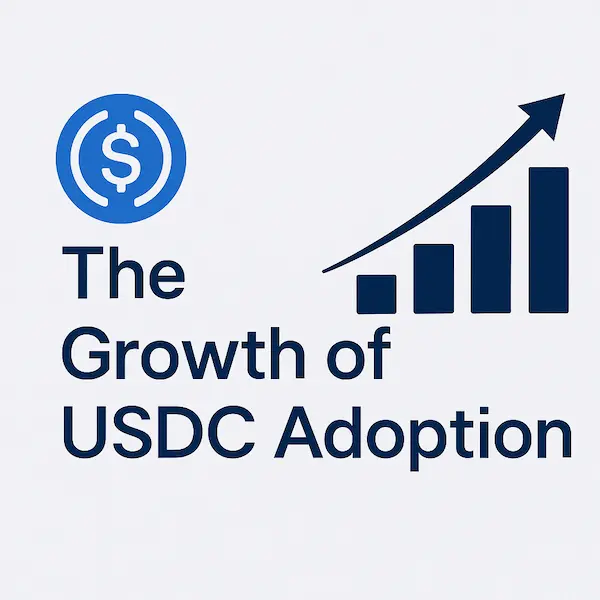
4. Pain Points of Traditional Payments
For decades, businesses have relied on credit cards, bank transfers, and international wire systems like SWIFT. While these methods are well established, they come with serious drawbacks that directly impact both merchants and customers. The hidden costs, slow settlement times, and security risks make it clear why many companies are now exploring alternatives such as stablecoins.
One of the biggest pain points is transaction fees. Credit card processors typically charge between 2% and 3% on every payment, which can add up to thousands of dollars per month for small and mid-sized businesses. International transfers are even worse—wires can cost $30 to $50 per transaction, plus unfavorable exchange rates. For a company that chooses to accept USDC payments, these costs are dramatically reduced, often to less than 1%.
Another challenge is settlement time. Traditional banking systems can take days to clear cross-border payments, locking up cash flow and slowing business operations. In contrast, when businesses accept USDC payments, the funds arrive within minutes, ready to be used or converted. For industries like e-commerce or freelancing, where speed and liquidity are critical, this advantage cannot be overstated.
Finally, traditional payments also expose merchants to risks like chargeback fraud and data breaches. Every year, businesses lose billions to fraudulent disputes and credit card scams. Stablecoin transactions, by design, eliminate chargebacks while providing transparent records on the blockchain. This is one of the strongest arguments for companies looking to accept USDC payments as a safer and more reliable option than legacy systems.
5. Why Businesses Should Accept USDC Payments
Switching to stablecoin transactions is no longer just an experiment—it’s becoming a necessity. Companies that choose to accept USDC payments gain significant financial and operational advantages compared to relying only on credit cards, PayPal, or bank wires. Below are the most important benefits that make USDC stand out in 2026.
1. Lower Transaction Costs
Credit card fees can eat into profits, with rates between 2% and 3%. For businesses processing thousands of transactions, this is a heavy burden. When merchants accept USDC payments, the cost drops to as little as 0.1–0.5% depending on the gateway. This saving directly improves margins, especially for SMEs and e-commerce platforms.
2. Instant Settlement and Improved Cash Flow
Traditional cross-border transfers can take days, while stablecoins settle within minutes. Accepting USDC means businesses don’t have to wait for intermediaries—funds are available almost instantly. This faster cash flow is especially valuable for global merchants, freelancers, and NGOs that rely on timely access to capital.
3. Transparency and Regulatory Compliance
Unlike other stablecoins, USDC is regularly audited and operates under strict regulatory oversight. This transparency reduces the risk of holding a digital asset and reassures customers. For companies wanting to accept USDC payments, this compliance layer makes it safer than alternatives like USDT.
4. Reaching Web3-Native Customers
A new generation of consumers is comfortable paying with digital wallets and stablecoins. Businesses that accept USDC payments position themselves as forward-thinking and open to Web3 users, giving them access to new markets and audiences.
Table 1: USDC vs USDT vs PYUSD vs Credit Card
| Feature | USDC | USDT | PYUSD | Credit Card |
|---|---|---|---|---|
| Stability | 1:1 USD, audited | 1:1 USD, less transparent | Backed by PayPal | Dependent on banks |
| Transaction Fees | 0.1–0.5% | 0.1–0.5% | 0.1–0.3% | 2–3% + hidden fees |
| Settlement Speed | Seconds–minutes | Seconds–minutes | Seconds–minutes | 1–3 business days |
| Compliance | Strong, regulated | Limited transparency | PayPal-linked | High but costly |
| Adoption 2026 | Rapid growth | Widely used | Emerging | Declining in online commerce |
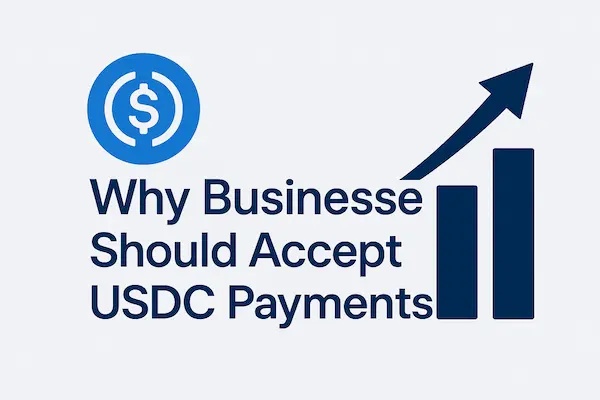
6. Integration Models for Accepting USDC
There are several ways businesses can integrate USDC into their payment systems. The choice depends on transaction size, technical resources, and customer preferences. Companies that decide to accept USDC payments can either use third-party gateways for simplicity or build direct integrations for full control.
Crypto Payment Gateways
Gateways such as XaiGate, Coinbase Commerce, and BitPay provide turnkey solutions. They handle custody, compliance, and settlement, allowing merchants to start accepting USDC quickly without heavy technical overhead.
Direct Wallet Invoicing
For businesses seeking more independence, generating wallet addresses or QR codes is an option. Customers send USDC directly, and merchants manage custody. This method offers full control but requires strong wallet security and internal accounting processes.
Plugins and APIs for E-commerce
Popular platforms like Shopify, WooCommerce, and Magento now offer plugins that make it easy to add USDC as a checkout option. Larger companies can use APIs to connect their accounting, ERP, or treasury systems, ensuring smooth reconciliation when they accept USDC payments.
Choosing the Right Blockchain Network
USDC is available on multiple chains including Ethereum, Polygon, Arbitrum, Optimism, Solana, and Tron. Each network offers a different balance of cost, speed, and reliability. Selecting the right chain helps optimize transaction costs and customer experience.
Table 2 – USDC Transaction Fees and Speeds Across Blockchain Networks (2026)
| Blockchain Network | Avg. Fee (2026) | Speed (TPS) | Pros | Cons |
|---|---|---|---|---|
| Ethereum | $2–5 | ~15 | Highly secure, widely adopted | Expensive, slow |
| Polygon (Layer-2) | <$0.05 | ~7,000 | Cheap, fast, Ethereum-linked | Relies on Ethereum layer |
| Arbitrum/Optimism | $0.1–0.3 | ~2,000 | Secure, lower fees | More complex UX |
| Solana | <$0.01 | 65,000+ | Extremely fast, very low cost | Occasional downtime |
| Tron | <$0.1 | ~2,000 | Popular in Asia, low fees | More centralized |
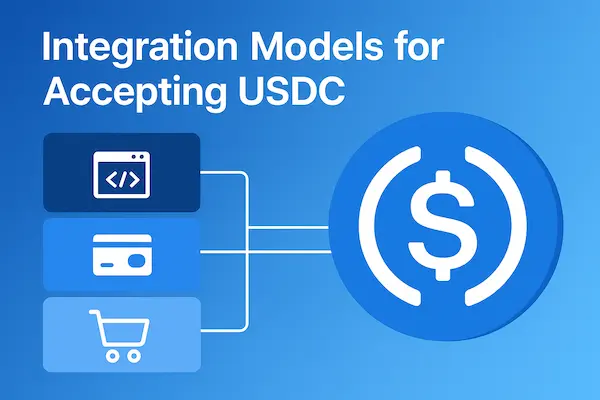
7. Real-World Examples & Case Studies
The adoption of USDC is not just theoretical—it’s already happening across industries. From global financial giants to small merchants, more organizations are choosing to accept USDC payments as part of their operations. These real-world cases highlight how USDC is being used to cut costs, improve transparency, and unlock new opportunities.
1. Visa Expands Settlements with USDC
Visa has integrated USDC for settlement on both Ethereum and Solana, proving that stablecoins can function at scale within global payment networks. This partnership gives merchants more confidence to accept USDC payments, knowing that one of the world’s largest financial companies is backing the infrastructure.
2. Shopify Merchants Reducing Costs
E-commerce sellers on Shopify who integrate gateways like XaiGate or Coinbase Commerce are saving up to 70% in processing fees compared to PayPal or credit cards. By accepting USDC, they enjoy faster cash flow and attract Web3-savvy customers who prefer stablecoin payments.
3. NGOs Leveraging Transparency
Organizations like UNICEF and the Red Cross have experimented with stablecoin donations, including USDC, to ensure transparency in humanitarian aid. Donors can see funds move on-chain, while NGOs avoid high banking fees. For nonprofits, the decision to accept USDC payments builds trust with supporters and reduces overhead.
4. Freelancers and Remote Workers
On platforms such as Deel and Upwork, freelancers are increasingly paid in stablecoins. Receiving USDC allows them to bypass SWIFT delays and expensive wire fees. For many digital workers, getting clients to accept USDC payments has become a key advantage in securing faster and fairer compensation.
8. Compliance, Security & Accounting
Adopting a new payment method comes with responsibilities. While the advantages of stablecoins are clear, businesses must also consider compliance, security, and accounting standards when they decide to accept USDC payments. Doing so ensures long-term trust with customers, regulators, and financial partners.
Custody Models – Self vs Hosted Wallets
Merchants can choose between self-custody, where they manage private keys directly, or hosted custody through a gateway provider. Self-custody provides full control but increases responsibility for security. Hosted solutions simplify operations and compliance, making it easier for businesses to accept USDC without managing wallets themselves.
Global Regulations and KYC/AML Requirements
Regulatory expectations vary across regions. In the U.S. and EU, payment providers that handle stablecoins must comply with KYC (Know Your Customer) and AML (Anti-Money Laundering) rules. Businesses that want to accept USDC payments should work with gateways like XaiGate or Coinbase Commerce, which already meet these standards, ensuring smoother cross-border operations.
Taxation and Accounting Considerations
Accepting stablecoins has tax implications. In most jurisdictions, payments received in USDC are treated the same as fiat revenue, requiring proper reporting and conversion rates at the time of transaction. Accounting teams need clear processes for reconciliation, ensuring that when companies accept USDC payments, their financial statements remain accurate and compliant.
Building a Secure Infrastructure
Security is paramount when handling digital assets. This includes multi-signature wallets, hardware wallets for treasury storage, and regular audits. By combining best practices with compliant gateways, businesses can accept USDC payments safely while minimizing operational risks.
9. Future of USDC in Global Payments
As stablecoins become mainstream, USDC is positioning itself as the leading digital dollar for global commerce. The question is no longer whether businesses should adopt it, but how quickly they can adapt. Companies that start to accept USDC payments now will be better prepared for the digital-first economy that is unfolding between 2026 and 2030.
Multi-Stablecoin Checkout Becomes Standard
In the near future, customers may expect to pay with multiple stablecoins, not just USDC. Gateways are already building systems that allow merchants to accept USDC, USDT, PYUSD, and others in a single checkout flow. By enabling businesses to accept USDC payments alongside other stablecoins, this approach increases flexibility and widens customer reach.
Programmable and Automated Payments
USDC’s integration with smart contracts is opening new possibilities like subscription billing, milestone-based escrow, and automated royalty distributions. For example, a SaaS business that decides to accept USDC payments could also set up automatic renewals on-chain, reducing administrative costs and improving efficiency.
CBDCs vs Stablecoins – A Dual System
Central banks are developing CBDCs, but rollout will take years. In practice, CBDCs and stablecoins are likely to coexist. Governments may push CBDCs for official transactions, while businesses continue to accept USDC payments for their speed, flexibility, and global reach. This dual system could make USDC an essential bridge currency between traditional banking and decentralized finance.

10. Strategic Recommendations for Businesses
Adopting USDC is not just about keeping up with trends—it’s about staying competitive in a global marketplace where speed and cost efficiency are critical. Businesses that decide to accept USDC payments should take a strategic approach, starting small and scaling as adoption grows.
SMEs and E-commerce Stores: Start by adding USDC as an optional checkout method through a payment gateway like XaiGate. This reduces costs while appealing to a growing base of Web3-native customers.
Freelancers and Agencies: Encourage clients to pay in USDC for faster cross-border settlements. This can eliminate high SWIFT fees and unlock immediate liquidity.
NGOs and Nonprofits: Use USDC to improve transparency in donations. Donors increasingly prefer organizations that can prove where funds go, and blockchain-based payments make this easy.
Large Enterprises: Run pilot programs to integrate USDC into treasury operations, especially for cross-border B2B payments. Early adoption builds operational experience before CBDCs enter the market.
Table 3 – Financial Benefits of Accepting USDC Payments
| Scenario | Traditional Payment Method | Accepting USDC Payments | Savings / Improvement |
|---|---|---|---|
| Cross-border e-commerce ($10k/mo) | ~3% fee = $300 | ~0.5% fee = $50 | $250 saved monthly |
| Freelancer payout $2,000 | $35–50 fee + 2–3 days delay | <$5 fee, settled in minutes | $30–45 saved + faster pay |
| NGO donation $100,000 | 2–5% bank fees, slow settlement | ~0.5% fee, transparent on-chain | $4,000+ saved |
| Hotel booking $500 | $15 fee + chargeback risk | <$2 fee, no chargeback | Cheaper & safer |
Final Thoughts: Why Businesses Should Accept USDC Payments in 2026
The digital economy in 2026 is no longer waiting for the future—it is already here. Stablecoins like USDC are proving that money can move faster, cheaper, and more transparently than ever before. Businesses that choose to accept USDC payments today are not just saving on transaction fees, they are aligning with a global shift in how value is exchanged online.
The trend is accelerating: Visa has expanded USDC settlements, e-commerce merchants are cutting costs by 70%, and NGOs are receiving donations on-chain with full transparency. These developments show that USDC is not just another payment option—it is becoming the backbone of modern commerce. Ignoring this change could leave businesses behind, while early adopters secure an advantage in both cost efficiency and customer trust.
For decision-makers, the message is clear: stablecoin adoption is moving faster than most predicted, and waiting for CBDCs to catch up is not a strategy. Companies that accept USDC payments in 2026 are future-proofing their operations while building credibility in an increasingly digital-first market.
Quick Summary – Why Accept USDC Payments in 2026
| Key Factor | Traditional Payments | Accepting USDC Payments |
|---|---|---|
| Transaction Fees | 2–3% + hidden charges | 0.1–0.5% via gateways |
| Settlement Time | 1–3 business days | Instant or within minutes |
| Transparency | Limited, opaque bank systems | Fully auditable on blockchain |
| Global Reach | Restricted by banks & FX | Borderless, digital-native |
| Risk Profile | Chargeback fraud, high costs | No chargebacks, lower overhead |
Don’t wait until competitors get ahead. Start accepting USDC today and unlock faster payments, lower costs, and global opportunities. Whether you run an online store, manage cross-border payroll, or accept donations, USDC provides a secure, transparent, and future-ready solution.
👉 Future-proof your business — integrate USDC payments with XaiGate and lead the way in the stablecoin revolution of 2026.
For daily updates, subscribe to XAIGATE’s blog!
We may also be found on GitHub, and X (@mxaigate)!
FAQs – Accept USDC Payments
1. Is it safe for businesses to accept USDC payments?
Yes. USDC is fully backed 1:1 by U.S. dollar reserves and audited regularly. When businesses accept USDC payments through trusted gateways, they minimize risks from volatility and fraud.
2. How can I integrate USDC payments into my website or store?
Integration is simple with gateways like XaiGate, Coinbase Commerce, and BitPay. Shopify and WooCommerce offer plugins, while APIs let developers build custom solutions. This makes it easy for merchants to accept USDC payments.
3. What are the fees when accepting USDC payments?
Fees are typically 0.1%–0.5% via crypto gateways—much lower than credit card fees of 2–3%. Companies that accept USDC payments can cut operational costs significantly.
4. Which industries benefit most from USDC adoption?
E-commerce, freelancers, NGOs, gaming, travel, and global marketplaces benefit the most. These industries often face high fees and delays, so choosing to accept USDC payments delivers speed and savings.
5. How does USDC compare with USDT and PYUSD for payments?
USDC is more transparent and compliant than USDT, while PYUSD is PayPal-backed but still new. Many businesses prefer to accept USDC payments for its regulatory clarity and strong institutional support.
6. Do businesses need licenses to accept USDC globally?
In most regions, no special license is required to accept USDC payments. Still, regulations vary, so merchants should use compliant gateways that handle KYC and AML.
7. Can small businesses and freelancers accept USDC payments?
Yes. USDC is perfect for SMEs and freelancers seeking affordable, instant cross-border transactions. Accepting USDC payments helps them serve international clients easily.
8. How are taxes handled when businesses accept USDC payments?
Most jurisdictions treat USDC income as revenue in local currency at settlement. Merchants that accept USDC payments must report values accurately for tax compliance.
9. What networks support USDC payments?
USDC is issued on Ethereum, Polygon, Arbitrum, Optimism, Solana, and Tron. Merchants can choose the most cost-effective network to accept USDC payments seamlessly.
10. What is the future of USDC in global payments?
Adoption is growing rapidly in 2026 as institutions and fintechs expand usage. Companies that accept USDC payments now gain a head start before CBDCs reach mainstream adoption.

